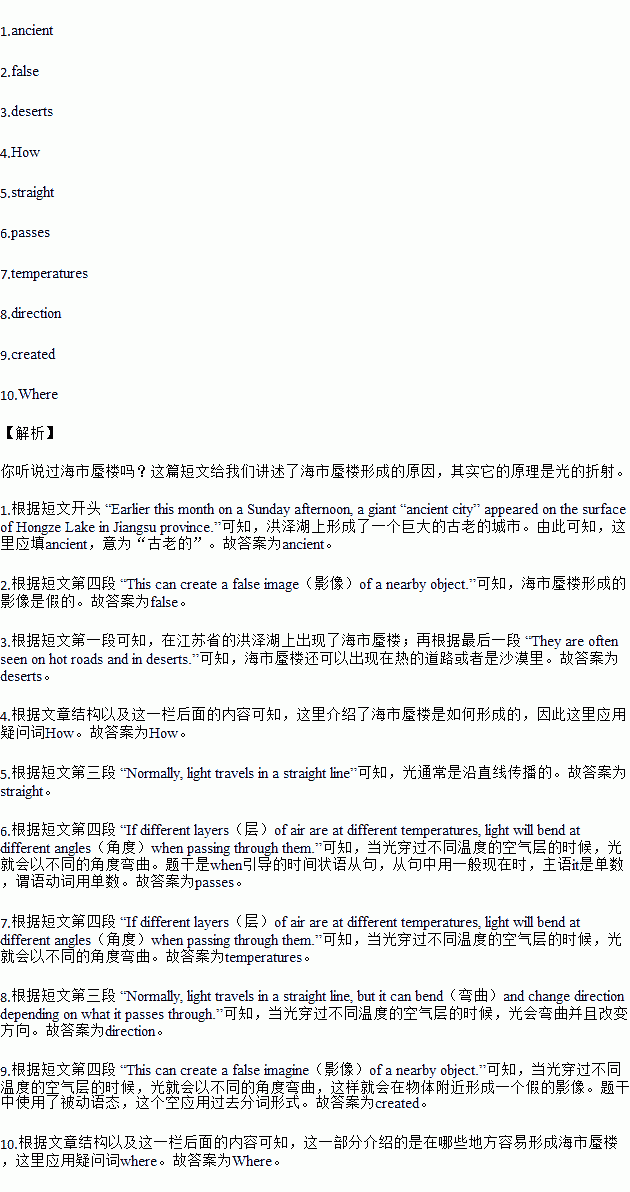题目内容
任务型阅读
Mystery of mirages
Earlier this month on a Sunday afternoon, a giant “ancient city” appeared on the surface of Hongze Lake in Jiangsu province. But after about half an hour, the “city” was gone.
You might think that some unknown forces were at work, but it’s believed that the “city on the lake” was actually a mirage.
A mirage is a trick that light and air play with bur vision(视觉). Normally, light travels in a straight line, but it can bend(弯曲)and change direction depending on what it passes through. This bending is called "refraction (折射)”.
If different layers(层)of air are at different temperatures, light will bend at different angles(角度)when passing through them. This can create a false image(影像)of a nearby object.
Take the “city on the lake” as an example. The layer of air near the lake is colder than the higher layers, as the lake absorbs(吸收)most of the heat. The buildings in the mirage were actually on a nearby mountain. But their image showed up above the lake after light refracted in different layers of air.
Mirages happen not only over large bodies of water, but anywhere where the ground can absorb a lot of heat. They are often seen on hot roads and in deserts. The next time you think you see a pool of water on the road on a hot summer day, you will know it's just a mirage—an image of the sky caused by bending light.
Mystery of mirages | |
A piece of news | A giant1.city appeared on Hongze Lake but disappeared about half an hour later. It’s believed that the city on the lake was in fact a mirage. |
What mirage is. | A mirage is a2.image of a nearby object that you can see on lakes, roads and in3.. |
4.it is created. | Light usually travels in a5.line. But when it6.through different layers of air that are at different7., it can bend at different angles and change8.. Then a mirage is9.. |
10.it can be seen. | Mirages can happen in any place where the ground can absorb a lot of heat. |
Timetables are important. They help you know what your classes are and when your classes are. They help you get to your classes on time. A class timetable has the names and time of all classes. A good timetable has other information too. You can write your teachers’ names on it. In some schools, students have the same class in the same place every day—from Monday to Friday. The following timetable(时间表)is fit(合适的) for those students.
Time | Monday | Tuesday | Wednesday | Thursday | Friday |
7:50 | Meeting | Meeting | Meeting | Meeting | Meeting |
8:20 | Chinese | English | Maths | English | Chinese |
9:05 | Morning Exercises | ||||
9:30 | Maths | Chinese | English | Chinese | Maths |
10:25 | Maths | Chinese | Maths | PE | |
11:45 | Lunch | ||||
12:45 | History | Music | PE | Music | English |
13:30 | PE | Art | History | Art | History |
14:15 | Biology | Geography | Biology | Geography | Meeting |
15:00 | |||||
Chinese : Mr Li Maths: Ms Feng English: Mr Black History: Mr Ge Geography: Mr Jiang Biology: Miss Song Art : Mr Xu Music: Mr Hu PE :Ms Wang Meeting: Ms Feng |
1.Why do we say the timetables are important?
A.Because they can help us do the homework well.
B.Because they can help us know about out subjects.
C.Because they can help us know a lot about our classmates.
D.Because they can help us know a lot about our teachers.
2.What does the timetable include(包括)?
a. the names of the subjects
b. the time of all classes
c. the names of the students
d. the teachers’ names
A.a c d B.a b c C.a b d D.a b c d
3.How many classes does Ms Feng have on Friday?
A.One B.Two C.Three D.Four
4.Which of the following is Not right?
A.The students have an hour for lunch.
B.The students have seven lessons a day.
C.The students go to school five days a week.
D.The students do morning exercises and play ball games every day.

